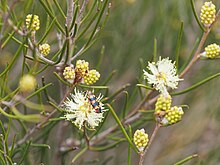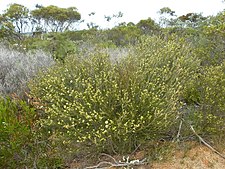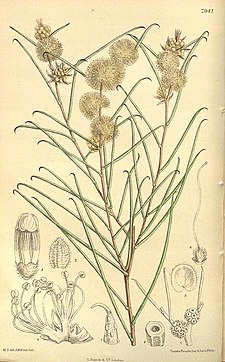Melaleuca uncinata
| Broombush | |
|---|---|

| |
| Melaleuca uncinata | |
| Scientific classification | |
| Kingdom: | Plantae |
| Clade: | Tracheophytes |
| Clade: | Angiosperms |
| Clade: | Eudicots |
| Clade: | Rosids |
| Order: | Myrtales |
| Family: | Myrtaceae |
| Genus: | Melaleuca |
| Species: | M. uncinata
|
| Binomial name | |
| Melaleuca uncinata | |
| Synonyms[1] | |
| |
Melaleuca uncinata, commonly known as broombush, broom honeymyrtle or brushwood, is a plant in the paperbark family native to southern Australia. It is harvested from the wild, and grown in plantations, for broombush fencing. The Noongar names for the plant are kwytyat and yilbarra.[2]
Description
Broombush is a multistemmed evergreen shrub usually less than 2 m (6 ft 7 in) in height, occasionally growing as a small tree to less than 5 m (16 ft). It is often found in association with mallee eucalypts. It has spreading or ascending leaves, 19–56 mm (0.75–2.20 in) long and 0.8–1.2 mm (0.031–0.047 in) wide, linear in shape, almost circular in cross-section, and tapering to a distinctly curved hook. The leaves have large oil glands along their edges.[3][4][5]
The flowers are white, cream or yellow, and are attractive to birds. They are arranged in dense almost spherical heads, 15–17 mm (0.59–0.67 in) in diameter in the leaf axils. Each head contains 4 to 19 groups of flowers, each group with 3 flowers. The stamens are arranged in five bundles around the flower, each bundle with 3 to 5 stamens which are cream, white or pale greenish-cream. Flowers appear from August to December and the fruit which follow are closely packed together forming a group with a diameter of 7–13 mm (0.3–0.5 in).[3][4][5]



Taxonomy
Melaleuca uncinata was first described in 1812 by
A review of the species was undertaken by Lyndley Craven in 1994 and some populations have been identified as new species. The populations in Queensland and New South Wales may also represent another taxon.[4]
Distribution and habitat
This melaleuca occurs in the
Ecology
Melaleuca uncinata is the only known host of the critically endangered Rhizanthella gardneri, the "underground orchid".[9][10]
Uses
Building material
Ornamental brushwood fencing comprising the grey stems, twigs and dry foliage of Melaleuca uncinata has been in use in Australia for more than 80 years. It is an important market for melaleucas although representing only 1% of the fencing market in Western Australia. Other uses include the manufacture of garden furniture, gazebos and hanging baskets. About 600,000 bundles of brushwood, each about 25 kilograms (55 lb) were used in Australia in 1994 with a predicted annual market growth of 5.5%.[4]
Essential oils
The leaves of this species have been analysed for their oil content. There appears to be different types of oil collected from two groups of plants. One group contained 1,8-cineole as its major component and the other terpinen-4-ol.[4]
References
- ^ a b "Melaleuca uncinata". Plants of the World Online. Retrieved 14 September 2021.
- ^ "Noongar names for plants". kippleonline.net. Archived from the original on 20 November 2016. Retrieved 11 December 2016.
- ^ ISBN 978-1876334987.
- ^ ISBN 9781922137517.
- ^ Department of Biodiversity, Conservation and Attractions.
- ^ Hooker, Joseph Dalton; Hemsley, William B. (1904). Curtis & Hooker's Botanical Magazine. London: Lovell Reeve & Co. p. 7941. Retrieved 27 November 2021.
- ^ "Melaleuca uncinata". APNI. Retrieved 14 March 2015.
- ^ Brown, Roland Wilbur (1956). The Composition of Scientific Words. Washington, D.C.: Smithsonian Institution Press. p. 826.
- ^ Dixon, K.W. (1990). "The Western Australian fully subterranean orchid Rhizanthella gardneri". Orchid Biology; Reviews and Perspectives. 5: 37–63.
- .
